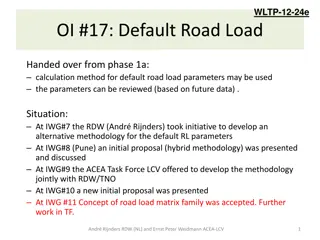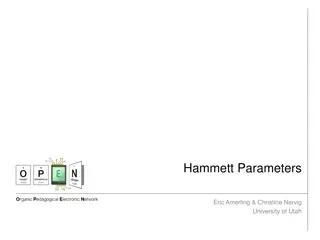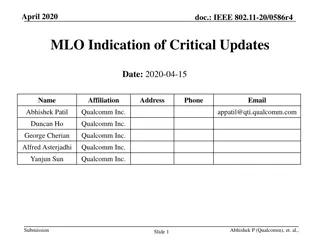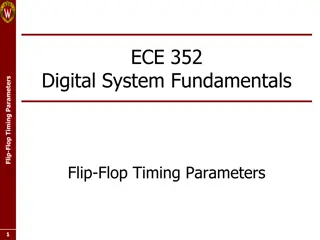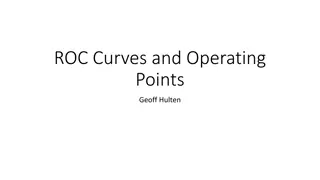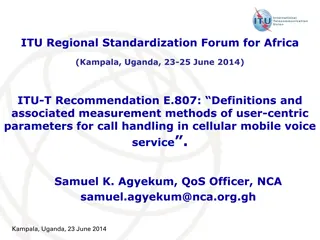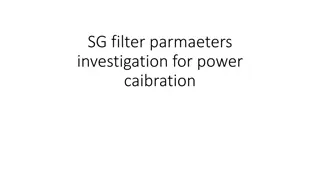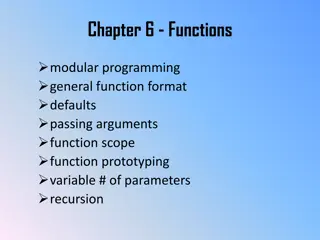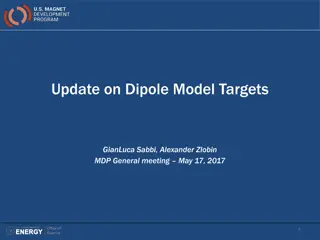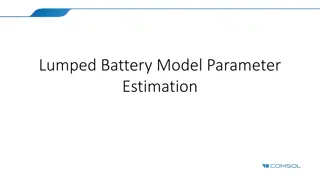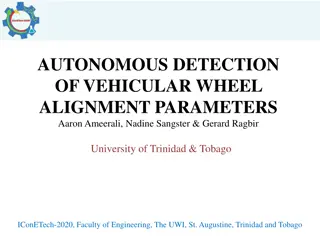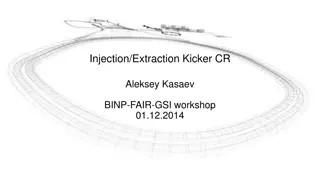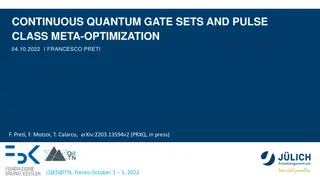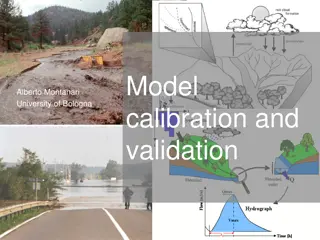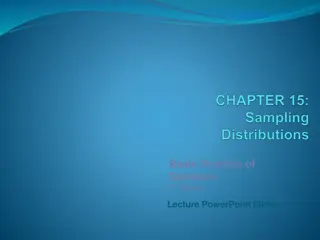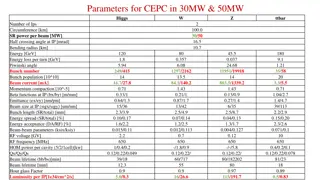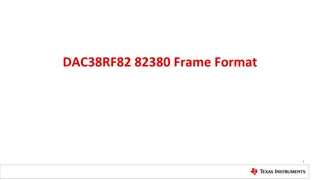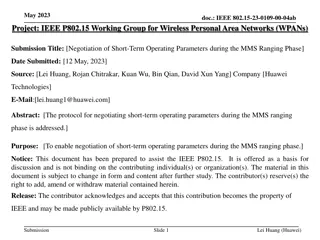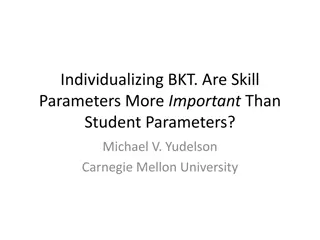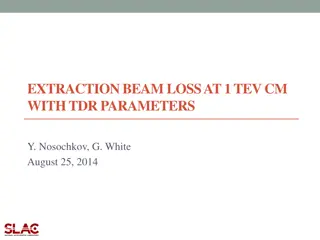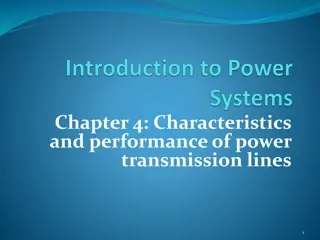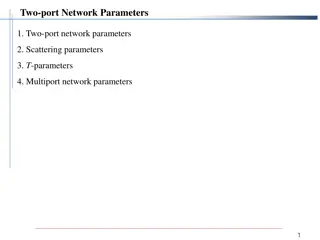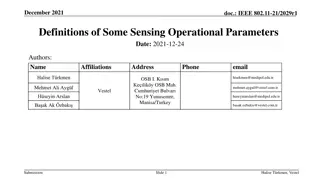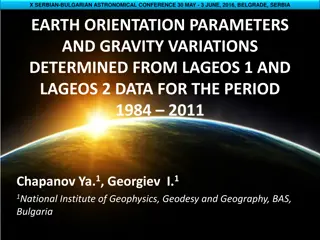- Development of Alternative Methodology for Default Road Load Parameters in Vehicle Testing
- The initiative to develop an alternative methodology for default road load parameters in vehicle testing was led by RDW and ACEA. The process involved multiple meetings, discussions, and proposals, resulting in the acceptance of the concept of a road load matrix family. Various x-factors were adop
3 views • 22 slides
Hammett Parameters in Organic Chemistry
The Hammett Parameters analysis, particularly the Hammett Plot, is a valuable tool in studying the electronic effects of substituents on aromatic systems. This linear free-energy relationship approach aids in optimizing reaction conditions and probing reaction mechanisms. Applications of Hammett Par
1 views • 8 slides
IEEE 802.11-20/0586r4 MLO Indication of Critical Updates
The document discusses the need for a mechanism in the MLO framework to enable non-AP MLDs to receive updates to operational parameters without monitoring all links. It proposes that each AP of an MLD should provide an indication of updates to another AP's operational parameters. It also outlines ho
1 views • 17 slides
Flip-Flop Timing Parameters in Digital Systems
In digital systems, flip-flop timing parameters are crucial for proper operation. Synchronous inputs must remain stable before and after the clock edge to ensure correct storage of values. Clock frequency, setup time, hold time, and propagation delay play key roles in signal integrity. By considerin
0 views • 9 slides
ROC Curves and Operating Points in Model Evaluation
In this informative content, Geoff Hulten discusses the significance of ROC curves and operating points in model evaluation. It emphasizes the importance of choosing the right model based on the costs of mistakes like in disease screening and spam filtering. The content explains how logistical regre
9 views • 11 slides
Building Engineering Systems Overview
Explore the standards, requirements, and parameters for building engineering systems, focusing on indoor microclimate conditions, energy efficiency, and optimal parameters for different seasons. Learn about European and Lithuanian standards, as well as specific parameters for school classrooms. Refe
0 views • 8 slides
PDSCH Demodulation Parameters & Requirements Discussion
This document covers the discussion on PDSCH demodulation parameters and requirements for UE demodulation and CSI reporting in FR2 DL 256QAM, specifically focusing on static channel mode, TDL-D channel mode, and TDL-A channel mode. The document also explores rank options, channel bandwidth, PRB allo
0 views • 9 slides
MFMSA_BIH Model Build Process Overview
This detailed process outlines the steps involved in preparing, building, and debugging a back-end programming model known as MFMSA_BIH. It covers activities such as data preparation, model building, equation estimation, assumption making, model compilation, and front-end adjustment. The iterative p
0 views • 10 slides
Automatic Optimization of Basis Set Parameters for Enhanced Quality
Learn how to automatically optimize the parameters that define the quality of the basis set with the Simplex code, as detailed by Alberto García Javier Junquera. This process involves compiling the Simplex code, preparing the necessary input files, creating a directory for running the optimization
1 views • 11 slides
User-Centric Parameters for Call Handling in Cellular Mobile Voice Service
The ITU Regional Standardization Forum for Africa held in Kampala, Uganda in June 2014 introduced ITU-T Recommendation E.807, focusing on the definitions and measurement methods of user-centric parameters for call handling in cellular mobile voice service. The recommendation outlines five key parame
1 views • 15 slides
Optimizing SG Filter Parameters for Power Calibration in Experimental Setup
In this investigation, the aim is to find the optimal SG filter parameters to minimize uncertainty in power calibration while avoiding overfitting. Analyzing power calibration measurements and applying SG filter techniques, the process involves comparing different parameters to enhance filter perfor
2 views • 21 slides
Regression Model for Predicting Crew Size of Cruise Ships
A regression model was built to predict the number of crew members on cruise ships using potential predictor variables such as Age, Tonnage, Passenger Density, Cabins, and Length. The model showed high correlations among predictors, with Passengers and Cabins being particularly problematic. The full
0 views • 16 slides
Functions in Modular Programming
Functions in modular programming allow for hierarchical decomposition of problems into smaller tasks, with interfaces defining input parameters and output. Each function operates independently, following a specific structure for headers, parameters, and return statements. Proper function prototyping
0 views • 27 slides
Update on Dipole Model Targets for MDP General Meeting May 17, 2017
The update covers the targets and specifications for the MDP 16 T Dipole model discussed during the general meeting on May 17, 2017. It includes details such as magnet dimensions, conductor specifications, operational parameters, geometrical field harmonics, coil stress, and more. The objectives and
1 views • 11 slides
Biomarkers and Maturity Parameters in Petroleum Exploration
Biomarkers and maturity parameters play crucial roles in characterizing source materials and assessing the thermal maturity of organic matter in petroleum exploration. Specific biomarkers and non-biomarker maturity parameters are utilized to determine the relative maturity of source rocks and oils.
0 views • 17 slides
Lumped Battery Model Parameter Estimation Overview
This information discusses the estimation of parameters for a lumped battery model, focusing on a black-box approach for lithium-ion battery performance prediction using experimental data and optimization methods. It covers background, experimental data, model fitting parameters, geometry, operating
0 views • 9 slides
Autonomous Detection of Vehicular Wheel Alignment Parameters
This research focuses on the autonomous detection of vehicular wheel alignment parameters conducted by Aaron Ameerali, Nadine Sangster, and Gerard Ragbir at the University of Trinidad & Tobago. The study addresses the importance of wheel alignment for proper road contact and maintenance, discussing
1 views • 19 slides
Water Quality Parameters and Characteristics
Water quality encompasses physical, chemical, and biological characteristics that determine its suitability for various uses. Physical parameters like turbidity, taste, odor, color, and temperature affect sensory perception. Chemical parameters such as pH, acidity, alkalinity, and hardness relate to
1 views • 26 slides
Analysis of Bunch Lengthening in CEPC for Different Design Parameters
This study explores bunch lengthening in the Circular Electron Positron Collider (CEPC) for various design parameters, analyzing a 54 km design scheme, a 61 km design scheme, and a 100 km design scheme. The analysis includes the theoretical framework used, equations for bunch lengthening, and conclu
1 views • 15 slides
Magnetic Field Calculation and Parameters for Injection/Extraction Kicker CR
This document provides detailed information on the injection/extraction kicker CR used by Aleksey Kasaev at the BINP-FAIR-GSI workshop in 2014. It includes main parameters of the kicker, magnetic field calculations, ferrite parameters, magnetic field distribution, and time cycles of operation. Addit
0 views • 11 slides
Optimizing Continuous Quantum Control with Variable Parameters
The research delves into solving quantum optimal control problems with versatile system parameters through robust and analytical approaches. It explores optimizing figures of merit in quantum systems with varying Hamiltonian and pulse parameters, showcasing solutions for single-qubit and two-qubit s
2 views • 18 slides
The Importance of Calibration in Hydrological Modeling
Hydrological models require calibration to adjust parameters for better representation of real-world processes, as they are conceptual and parameters are not physically measurable. Calibration involves manual trial and error or automatic optimization algorithms to improve model accuracy. Objective f
0 views • 12 slides
Parameters, Statistics, and Statistical Estimation in Statistics
In statistics, we differentiate between parameters and statistics, where parameters describe populations and statistics describe samples. Statistical estimation involves drawing conclusions about populations based on sample data. The Law of Large Numbers explains the relationship between sample stat
2 views • 12 slides
CEPC Main Ring Double Ring Scheme Lattice Design
Lattice design and parameters for the double ring scheme of the Circular Electron Positron Collider (CEPC) main ring discussed at the CEPC AP meeting in January 2016. The outline covers the CEPC parameters for C=100km, including the lattice design and geometry for different regions. Details on energ
0 views • 14 slides
Channel Generation Process for IEEE 802.11aj (45GHz) Based on Channel Measurement
This presentation by Haiming Wang and team from SEU/CWPAN discusses the process of channel realization and generation in the 45 GHz bandwidth. It covers the generation of the channel impulse response, modeling of parameters, statistical measurements, and future work related to the 802.11ad standard.
0 views • 27 slides
Predicting Number of Crew Members on Cruise Ships Using Regression Model
This analysis involves building a regression model to predict the number of crew members on cruise ships. The dataset includes information on 158 cruise ships with potential predictor variables such as age, tonnage, passengers, length, cabins, and passenger density. The full model with 6 predictors
1 views • 15 slides
Parameters and Results for CEPC in 30MW & 50MW
Parameters and results for the Circular Electron Positron Collider (CEPC) operating at 30MW and 50MW including information on the Higgs, W, Z, and ttbar processes. The data covers various aspects such as the number of IPs, circumference, power per beam, bending radius, energy, beam properties, beam-
0 views • 7 slides
Transport Layer Parameters and Examples
This content delves into the important parameters associated with the transport layer, such as the number of lanes per converter device, the number of converters per device, and the number of octets per frame. It provides examples of how these parameters are configured in different scenarios, showca
3 views • 8 slides
Negotiation of Short-Term Operating Parameters in MMS Ranging
This document addresses the protocol for negotiating short-term operating parameters during the MMS ranging phase in IEEE P802.15 working group for wireless personal area networks (WPANs). The purpose is to enable negotiation of these parameters to enhance efficiency and performance. The submission
0 views • 11 slides
Individualizing Bayesian Knowledge Tracing: Skill vs. Student Parameters
Modeling student learning variability and the impact of skill and student-level factors in predicting performance using Bayesian Knowledge Tracing. Exploring the importance of individualization and understanding the influence of skill parameters versus student parameters.
0 views • 18 slides
Quantitative Parameters for Studying Ink and Paper Exposure
Fading of printed pages in sunlight, especially with specific ink and paper types, prompted the proposal of quantitative parameters for prolonged exposure study. Evaluation of theory strengths and weaknesses revealed the lack of quantitative fading parameters and an absence of a theoretical model. T
0 views • 7 slides
Extraction Beam Loss at 1 TeV CM with TDR Parameters
This study conducted on August 25, 2014, explores the extraction beam loss at 1 TeV CM using TDR parameters. The research delves into disrupted beam distributions, beamline optics, electron and photon power losses, and energy spreads. Detailed analysis and simulations are presented to understand the
0 views • 18 slides
Characteristics and Performance of Power Transmission Lines
Transmission lines are crucial components in power systems that require a deep understanding of their characteristics and performance. The analysis is often done on a per-phase basis using two-port network representations with A, B, C, and D parameters. These parameters, which depend on line paramet
0 views • 38 slides
SOA Surrogate Species Parameters Analysis
This data provides parameters for various surrogate species used in the May 2015 version of UCI-CIT, including vapor pressure, UNIFAC parameters, Henry's Law constants, and more. The parameters are calculated using various methodologies such as SIMPOL 1, UNIFAC, and Suzuki HLC. Detailed values for s
0 views • 14 slides
Java Method Parameters
Learn about passing parameters in Java methods, including implicit and explicit parameters, formal parameters, and actual parameters. Understand the relationship between formal and actual parameters and how values are passed during method calls. Explore the concept of parameter passing and its impli
0 views • 31 slides
Analyzing Statistics and Parameters
In this section on Statistics and Parameters, learn about statistical inference, sample statistics, population parameters, and measures of central tendency and variation. Understand how statistics are used to draw conclusions about populations and differentiate between sample statistics and populati
0 views • 19 slides
TSG-RAN WG4 Meeting Recap on Antenna Parameters
During the TSG-RAN WG4 Meeting #94-e-Bis, discussions focused on antenna parameters for different scenarios and frequency ranges. Agreements were reached on wide area coverage and additional parameters for AAS antennas. Detailed analysis was presented on elements, beamwidth, gain, and configurations
0 views • 5 slides
Understanding Two-Port Network Parameters and Conversions
Delve into the realm of two-port network parameters including impedance, admittance, a-parameters, b-parameters, h-parameters, g-parameters, and parameter conversions. Explore the definitions, complexities, and applications of these network parameters for low-frequency circuits, transmission, and ca
0 views • 46 slides
IEEE 802.11-21/2029r1 Sensing Operational Parameters Definitions
This document discusses the definitions of sensing operational parameters in IEEE 802.11-21/2029r1, focusing on negotiation processes, performance adjustments, and predefined parameters for popular use-cases. It emphasizes the importance of defining specific parameters to meet the varied requirement
0 views • 23 slides
Earth Orientation Parameters and Gravity Variations from LAGEOS Data
Explore the findings presented at the Serbian-Bulgarian Astronomical Conference in 2016, showcasing the determination of Earth orientation parameters and gravity variations using data from LAGEOS 1 and LAGEOS 2 spanning the period of 1984 to 2011. The conference discussed the processing of Satellite
0 views • 13 slides
